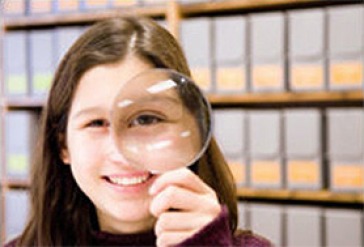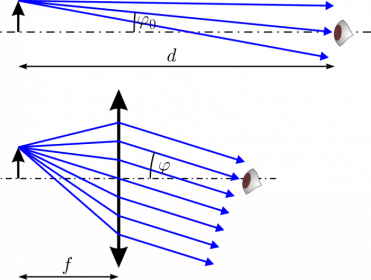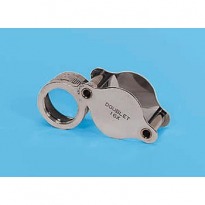Magnifying Glasses, Doublet and Triplet Lenses — Promote Clarity and Detail in Research

Magnifying Glass Enlarges a Real Eye for Science Seeing and Thinking
As people worked with glass — heated, shaped, refined and even blown — they came upon an interesting finding that some orbs of glass could actually magnify things and make them appear larger than their actual size. These convex pieces of glass became more and more popular. Soon handles were added to the magnifier glass, this permitted the magnifier to be easily handled, moved and positioned over an object to observe. Other pieces of glass were ground, shaped, smoothed and polished and put in wire rims and fitted over the eyes to make reading glasses. Benjamin Franklin is credited as the first American to make spectacles.
These magnifying and enlarging instruments and tools of science enable scientists to enhance an objects's size and see details that escape the unaided eye. There is a profound difference between the normal size something and when objects are magnified 10 to 20 X— any scientist, young or older, soon discovers this when using a good magnifier. Many
interesting observations and experiments can be promoted with a simple magnifier. Some of these experiments can be done with simple papers and crystals, and other experiments with fingerprints are excellent starting points for interested beginners
These magnifying and enlarging instruments and tools of science enable scientists to enhance an objects's size and see details that escape the unaided eye. There is a profound difference between the normal size something and when objects are magnified 10 to 20 X— any scientist, young or older, soon discovers this when using a good magnifier. Many
interesting observations and experiments can be promoted with a simple magnifier. Some of these experiments can be done with simple papers and crystals, and other experiments with fingerprints are excellent starting points for interested beginners
Magnifying Glasses and Hand Lenses, How They Work

Magnifying Lens, Object at Focal Distance, Ray Tracing
The magnifying glass is a convex lens that enlarges an object and forms an image that is typically 2 to 10 times larger than the object. Field or gem magnifiers are able to magnify objects from 10 to 20x their normal size. Note f = the focal distance to see the object well and magnified. The f varies based on the power and type of lens.
These simple instruments or tools reveal some details that are not seen by the normal eye, but microscopes that magnify 100 to 1,000x are the scientific instruments that really reveal the details and forms of things that the eye cannot see. The eye can resolve 2 lines as separate at about 0.2 mm (millimeter= 1 thousandth of a meter); the best visible light microscopes can resolve as separate two thin lines that are separated by 0.2 um (micrometers = 1 millionth of a meter), or 1,000x better than the unaided human eye.
These simple instruments or tools reveal some details that are not seen by the normal eye, but microscopes that magnify 100 to 1,000x are the scientific instruments that really reveal the details and forms of things that the eye cannot see. The eye can resolve 2 lines as separate at about 0.2 mm (millimeter= 1 thousandth of a meter); the best visible light microscopes can resolve as separate two thin lines that are separated by 0.2 um (micrometers = 1 millionth of a meter), or 1,000x better than the unaided human eye.
Magnifiers, Hand Lenses and Gem Lenses, Wise Choices and Care

Hand Lens 16x Magnifier (Carolina Biological)
There are a few ideas to keep in mind when getting a magnifier, hand lens for personal use:
1. glass lenses are preferred to plastic, since glass is more scratch-resistant and is easier to clean.
2. a protective built-in slide cover or case provides lens protection.
3. lenses with magnification, e.g 10x, 20x, and 30x are excellent choices for revealing details.
4. doublet lens have 2 lenses cemented together, triplets have 3 and are corrected for color aberration.
5. price ranges for lenses are about $5 to $26 (for the higher end jeweler, gem Hastings triplet).
VISIT Our Science Super School Store
All the Written Material within Site is Copyrighted 2010 and Owned by Dr. Donald Reinhardt, and this original material is protected legally by this copyright notice and by the Digital Millennium Act. None of this original material may be copied or reproduced without the expressed written consent of the author.
The author is a Freelance Science writer, and is available for specific assignments for those who are interested – by contacting adminstrator@sciencesuperchool.com. Other questions related to this teaching site should be directed to teacher@sciencesuperschool.com.
1. glass lenses are preferred to plastic, since glass is more scratch-resistant and is easier to clean.
2. a protective built-in slide cover or case provides lens protection.
3. lenses with magnification, e.g 10x, 20x, and 30x are excellent choices for revealing details.
4. doublet lens have 2 lenses cemented together, triplets have 3 and are corrected for color aberration.
5. price ranges for lenses are about $5 to $26 (for the higher end jeweler, gem Hastings triplet).
VISIT Our Science Super School Store
All the Written Material within Site is Copyrighted 2010 and Owned by Dr. Donald Reinhardt, and this original material is protected legally by this copyright notice and by the Digital Millennium Act. None of this original material may be copied or reproduced without the expressed written consent of the author.
The author is a Freelance Science writer, and is available for specific assignments for those who are interested – by contacting adminstrator@sciencesuperchool.com. Other questions related to this teaching site should be directed to teacher@sciencesuperschool.com.